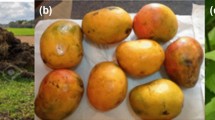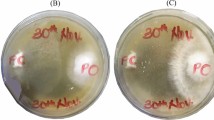Abstract
A variety of chemical treatments was examined for the ability to decrease the relative lignin content and increase the in vitro dry matter digestibility of peanut hulls. Of these chemical treatments, nitric acid was the most successful at removing lignin; however, none of the chemical treatments alone significantly increased digestibility of the hulls. Biodegradation of nitric acid-treated hulls by the lignin-degrading bacterium, Arthrobacter sp. KB-1, further decreased lignin content and dramatically increased the digestibility and nutritive value of the hulls.
This is a preview of subscription content, access via your institution
Access options
Subscribe to this journal
Receive 12 print issues and online access
$209.00 per year
only $17.42 per issue
Buy this article
- Purchase on Springer Link
- Instant access to full article PDF
Prices may be subject to local taxes which are calculated during checkout
Similar content being viewed by others
References
Sarkanen, K.V. and Ludwig, C.H. (eds.). 1971. Lignins: occurrence, formation, structure, and reactions. Wiley-Interscience, New York.
Crawford, R.L. 1981. Lignin biodegradation and transformation. Wiley-Interscience, New York.
Benner, R., Maccubbin, A.E. and Hodson, R.E. 1984. Anaerobic biodegradation of the lignin and polysaccharide components of ligno-cellulose and synthetic lignin by sediment microllora. Appl. Environ. Microbiol. 47: 998–1004.
Joshi, D.C. 1972. Different measures in the prediction of the nutritive value of forages. Acta Agric. Scand. 22: 243–247.
Barton, F.E. II, Amos, H.E., Albrecht, W.J. and Burdick, D. 1974. Treating peanut hulls to improve digestibility for ruminants. J. Anim. Sci. 38: 860–864.
Albrecht, W.J. 1979. Peanut hulls: their properties and potential uses. U.S. Department of Agriculture agricultural research bulletin ARM-S-1. U.S. Department of Agriculture, Washington, D.C.
Kerr, T.J., Kerr, R.D. and Benner, R. 1983. Isolation of a bacterium capable of degrading peanut hull lignin. Appl. Environ. Microbiol. 45: 1201–1206.
AOAC, 1975. Official Methods of Analysis (12th Ed.).Association of Official Analytical Chemists, Washington. D.C.
Updegraff, D.M. 1969. Semimicro determination of cellulose in biological material. Anal. Biol. 32: 420–424.
Effland, M.J. 1977. Modified procedure to determine acid-insoluble lignin in wood and pulp. TAPPI 60(10): 143–144.
Morris, D.L. 1948. Quantitative determination of carbohydrates with drywoods anthrone reagent. Science 107: 254–255.
Tilley, J.M.A. and Terry, R.A. 1963. A two stage technique for the in vitro digestion of forage crops. J. Brit. Grass Soc. 18: 104–111.
Kirk, T.K. and Chang, H.-M. 1981. Potential applications of bioligninolytic systems. Enzyme Microb. Technol. 3: 189–196.
Fan, L.T., Lee, Y.-H. and Gharpuray, M.M. 1982. The nature of lignocellulosics and their pretreatments for enzymatic hydrolysis. Adv. Biochem. Eng. 23: 157–187.
Author information
Authors and Affiliations
Rights and permissions
About this article
Cite this article
Kerr, T., Windham, W. & Benner, R. Chemical and Bacterial Pretreatment of Lignocellulosic Material to Increase Ruminant Digestibility. Nat Biotechnol 2, 805–807 (1984). https://doi.org/10.1038/nbt0984-805
Received:
Accepted:
Issue Date:
DOI: https://doi.org/10.1038/nbt0984-805



